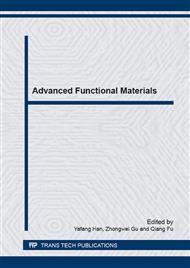p.67
p.72
p.76
p.80
p.89
p.97
p.103
p.109
p.115
Effect of Acetic Acid/Water Ratio on the Microstructure and Properties of LaNiO3 Thin Films by Metal Organic Solution Deposition
Abstract:
Highly (100)-oriented LaNiO3 (LNO) thin films were prepared on p-type Si (100) substrates by metal organic solution deposition (MOSD). The LNO thin films were driven by series precursor solutions with different ratio of acetic acid to deionized water (Raaw) and pH values. The dependences of viscosity, pH value and the thermal property of the gel-derived powders of the precursor solution on Raaw values were systematically investigated. AFM images showed that Raaw can dramatically influence the surface roughness. When Raaw changed from 7:1 to 1:1, the surface roughness decreased from 3.695 nm to 1.488 nm. The resistivities of all the films are less than 2.1×10-3Ω·cm. It shows that the precursor solution has strong effect on the microstructure of the thin films and relatively slight effect on the resistivity.
Info:
Periodical:
Pages:
89-93
Citation:
Online since:
March 2015
Authors:
Keywords:
Price:
Сopyright:
© 2015 Trans Tech Publications Ltd. All Rights Reserved
Share:
Citation:


